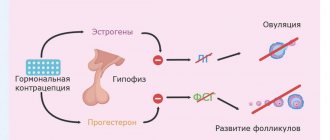Every girl or woman may experience menstrual irregularities.
At some point in her life, cycle disturbances probably occurred in every woman. Irregular periods, which many women are accustomed to considering as something ordinary, are actually a signal of problems with women’s health.
What is NMC in gynecology? This is a disrupted menstrual cycle that happens to women at different periods of their lives.
Irregular menstruation - delays or a shorter cycle, indicate disturbances in the physical or mental state of the woman. The monthly cycle is a kind of biological clock of the body. A disruption in their rhythm should alert you and cause you to consult a doctor so that diseases can be identified in a timely manner. Below we will talk about why the menstrual cycle fails and what a woman should do in such a situation.
A little about menstruation and the menstrual cycle
The first menstruation or menarche occurs in girls around 12–14 years old, and the further south the child lives, the earlier her periods begin. Menstruation ends around 45–55 years of age (this period is called premenopausal).
Menstruation is the shedding or desquamation of the functional layer of the uterine lining in response to decreased progesterone production. This is why gynecologists like to repeat that menstruation is the bloody tears of the uterus due to an unfulfilled pregnancy. To understand this definition, it is worth remembering the physiology of the menstrual cycle. As you know, a woman’s monthly cycle is divided into 3 phases:
- In the first, follicular phase, estrogens are produced, the action of which causes the maturation of follicles. From these follicles the main or dominant follicle is released, from which a mature egg is subsequently released.
- The second phase is the shortest (about a day), it is during this period that the main follicle ruptures, and the mature egg is released “free”, ready to meet the “live animals” and fertilize.
- In the third phase, the luteal phase, the synthesis of progesterone by the corpus luteum, which arose at the site of the ruptured follicle, begins. It is progesterone that prepares the endometrium for implantation of a fertilized egg. If conception does not occur, the corpus luteum slowly “dies” (regresses), progesterone production drops and endometrial rejection begins, that is, menstruation.
Then estrogen production gains strength again and the cycle repeats.
From all that has been said, it becomes clear that the menstrual cycle is called cyclic changes that occur in the body after a strictly defined time.
How to calculate the monthly cycle and determine the failure
The period of time from the onset of menstruation to the next is the menstrual cycle. Ovulation is the process of release into the fallopian tube of an egg ready for fertilization. It divides the cycle into two phases: follicular (the process of follicle maturation) and luteal (the period of time from ovulation to the onset of menstruation). In girls with a 28-day menstrual cycle, ovulation, as a rule, occurs on the 14th day from their onset. After ovulation, the level of estrogen in the female body drops, but bleeding does not occur, since the corpus luteum controls the production of hormones. Strong fluctuations in estrogen levels in one direction or another at the time of ovulation can cause uterine bleeding between, before and after menstruation.
The normal monthly cycle lasts 21-37 days, usually the cycle is 28 days. The duration of menstruation is usually 3-7 days. If the monthly cycle is off by 1-3 days, this is not considered a pathology. But if menstruation does not occur 7 days after the due date, you should consult a doctor for advice.
How to calculate your monthly cycle? The time interval between 1 day of the beginning of menstruation and 1-1 days of the next one is the duration of the cycle. In order not to make mistakes, it is better to use a calendar where you can mark the start and end of menstruation.
In addition, there are now quite a few computer programs that help with calculations. With their help, you can calculate the time of ovulation and even track the onset of premenstrual syndrome (PMS).
You can most accurately calculate your monthly cycle using basal temperature charts. The temperature in the first days after menstruation stays within 37°C, after which it sharply drops to 36.6°C, and the next day it rises sharply to 37.5°C and remains within these limits until the end of the cycle. And then a day or two before menstruation it decreases. If the temperature does not drop, pregnancy has occurred. If it does not change throughout the entire cycle, ovulation does not occur.
Symptoms indicating menstrual irregularities:
- increasing the time interval between menstruation;
- shortening of the monthly cycle (cycle less than 21 days);
- scanty or, conversely, heavy periods;
- absence of menstruation;
- the appearance of spotting and/or bleeding.
Also a negative symptom is the duration of menstruation less than three or longer than seven days.
Causes of menstrual irregularities
The main reason for the disruption of the menstrual cycle is hormonal imbalance. This happens in various diseases and conditions. The hereditary factor also plays an important role - if ancestors on the female line had disruptions in the cycle or other disorders, it is quite possible that this will affect the nature of menstruation in women in subsequent generations.
Lack of sleep, stress, excessive physical activity, psychological fatigue, change in time zone or climatic conditions can lead to irregular periods. It is not uncommon to experience menstrual problems in those who regularly stay awake at night. Brain tumors and neuroviral infections can also lead to menstrual irregularities.
Disturbed hormonal cycles are also observed in many diseases. Most often this happens against the background of pathologies of the endocrine and genitourinary systems, such as:
- genetic and hormonal pathologies of the ovaries;
- inflammation of the uterus and appendages;
- infectious lesions of the pelvic organs;
- diabetes;
- diseases of the thyroid gland, adrenal glands;
- obesity, etc.
Functional disorders of the endocrine system, manifested in the accumulation of estrogen with a simultaneous deficiency of progesterone, also cause menstrual irregularities. The cycle can be disrupted due to any infectious and non-infectious diseases, acute or chronic.
Treatment
Conservative therapy
Management tactics are chosen depending on the causes of symptom development:
- Mental disorders.
If a disorder occurs against the background of acute and chronic stress, it is necessary to create a favorable psychological environment, normalize the daily routine, psychotherapy, and sometimes take psychotropic drugs. Treatment of anorexia nervosa is challenging and often requires hospitalization. It is produced using diet therapy, psychotherapy, sex hormones, antipsychotics, H1-histamine blockers. - Ovarian failure.
Stimulation of ovulation is usually ineffective. If there is no desire to have a child, patients are prescribed hormone replacement therapy. If there are reproductive plans, IVF with a donor egg is indicated against the background of preliminary estrogen-gestagen stimulation and subsequent hormonal support until the 15th week of pregnancy. - Progesterone deficiency.
Progesterone preparations are recommended. The treatment plan is drawn up individually, taking into account age, the causes of pathology, hormonal levels in various phases of the cycle, the nature of menstrual disorders, etc. It is necessary to treat the underlying disease and secondary disorders, correct the regimen, eliminate stress, normalize the emotional state using sedatives. - Endocrine pathologies.
Therapeutic tactics are determined taking into account the type of disease. Replacement therapy is carried out using synthetic analogs of thyroid hormones, mineralocorticoids, and glucocorticoids. With hypercortisolism, agents are required to suppress the secretion of ACTH and blockers of steroid hormone production.
Chemotherapy is effective for some adrenal tumors. Patients who have undergone adrenalectomy are advised to take hormonal medications for life.
Surgery
Women undergo the following surgical interventions:
- Ovarian insufficiency:
bilateral oophorectomy in the presence of a Y chromosome for the prevention of ovarian germ cell malignancies. - Progesterone deficiency:
drilling or wedge resection for polycystic disease. - Adrenal tumors:
open or laparoscopic adrenalectomy for benign neoplasms, extended and combined operations for malignant neoplasia. - Cushing's disease:
bilateral adrenalectomy in severe cases, transcranial or transnasal tumor removal for pituitary adenoma.
Any woman can experience menstrual irregularities
Failures can be associated not only with diseases of the pelvic organs, but also with disorders in the endocrine, nervous, and immune systems. It should also be remembered that sometimes they signal the development of certain infectious diseases or pathological conditions:
- ectopic pregnancy;
- neoplasms in internal organs;
- malignant or benign neoplasm in the uterus or on its surface;
- STD;
- tuberculosis.
Some girls believe that tampons also provoke changes in the cyclicity of menstruation, but this opinion is incorrect. They are the same means of hygiene during menstruation as pads and menstrual cups.
When to see a doctor
Due to hormonal imbalances, the inner layer of the uterus - the endometrium - becomes excessively thick and compressed between the walls of the uterus. The “squeezed” endometrium receives little blood. When the level of oxygen and nutrients in the cells drops, they die and the mucous membrane is sloughed off. The process occurs unevenly, so bleeding is often heavy and/or prolonged2,3.
Sometimes, even after a long delay, a little blood is released, but if the bleeding lasts more than 10-15 days, you need to consult a doctor2.
Since bleeding occurs due to a violation of the cycle, they are not called menstruation, but dysfunctional uterine bleeding. They often lead to anemia, in which the number of red blood cells in the blood decreases and the blood's ability to carry oxygen decreases. Oxygen starvation of the brain leads to the girl feeling weak, dizzy and complaining of “fly spots” flashing before her eyes2.
Only a doctor can understand the intricacies of symptoms and find the cause of irregular periods. Therefore, if cycle disruptions occur frequently , you should definitely contact a gynecologist. If you are under 18 years old, make an appointment with a pediatric gynecologist.
What is considered a menstrual disorder?
- Delay of menstruation by more than 10 days.
- Shortening the cycle by 5-7 days.
- Increase or decrease in the volume of menstrual flow.
- Accompanying menstruation with deterioration of well-being and/or severe pain.
- Discharge of blood outside of menstruation (minor bleeding during ovulation is part of the norm).
- Complete cessation of menstruation before menopause.
- Uterine bleeding during menopause.
In order for a change in a cycle to be called a violation, it must be repeated over several cycles. Situational, that is, single changes (increasing or shortening the cycle by 5-7 days) are not violations and are considered a type of norm.
Regular cycles - what is normal
Normal cycles in women last 26-32 days, and the intervals between them are constant. Differences in the duration of individual cycles, not exceeding 4 days, are within normal limits.
Phases of the menstrual cycle
A measure of blood loss is the number of sanitary pads used. There should be at least 3 of them per day and no more than 7-10.
Proper menstruation lasts from 3 to 7 days. Small painful cramps at the beginning of menstruation are considered natural. Severe pain during menstruation should alert you and be a reason for a gynecological examination.
Symptoms of menstrual irregularities
Too scanty or, conversely, abnormally heavy periods have their own characteristic symptoms. It is well known that any disturbances in the human body never go away without a trace, and a disruption in the menstrual cycle can be recognized by the following signs:
- disturbance in the regulation of bleeding;
- copious discharge with the presence of clots;
- significant delay;
- very scanty menstruation;
- painful attacks of various types;
- premenstrual syndrome.
In the case of normal menstruation, the woman does not feel any significant symptoms. In some cases, a nagging pain in the lower abdomen may appear, which does not particularly disturb the general rhythm of life. If the menstrual cycle is disrupted, the pain syndrome can become too severe, the pain can radiate to the hip and lower back.
The intensity of the syndrome is determined by the following indicators:
- loss of ability to work – it’s hard to sit, do usual work, there is a constant desire to lie down;
- number of painkillers taken;
- In adolescents, menstrual irregularities are often caused by excessive emotional stress that arises from the expectation of bleeding.
Popular questions
My periods are irregular.
What to do in this case? It is necessary to make an appointment with an obstetrician-gynecologist. Conduct an examination to determine the cause of ovarian-menstrual irregularities. Therapy will eliminate unfavorable factors and restore the regularity of the cycle.
The cycle is not standardized. This time it was 35 days. Let's go, as I thought, brown periods. And it anointed for two days and stopped. There is no pain, discomfort, or unpleasant odor. The breasts did not hurt before menstruation, although they usually swell and ache. With the beginning of this menstruation I started drinking OK. Why is there no normal menstruation?
I recommend excluding possible pregnancy. If the test is negative, then you should continue taking the contraceptive. When starting to use CHCs, there may be a reduction in the volume of menstrual flow.
Hello! My cycle lasts 27 days, for six months, previously it was 30, and there were no failures, on the 11th-12th day my breasts swelled and hurt, and during this period she only got sick on the 24th day of the cycle, what could it be? Could there be some kind of failure and what could this be connected with?! Who to contact!? And yet, now it’s already the 30th day, maybe we’ll get back to the 30-day cycle...
Hello! An interval of 21-36 days for the menstrual cycle is considered normal. Fluctuations can be associated with various external and internal factors: changes in climate zones, diseases, physical activity, etc. The normal occurrence of mastodenia is that there should be no pain in the mammary glands. Therefore, you can make an appointment with an obstetrician-gynecologist and mammologist to exclude the development of possible diseases. At this stage, I recommend starting to take the product - Gynocomfort Evening Primrose Oil. This will help stabilize the cycle and eliminate pain and engorgement in the mammary glands. The product is taken 2 capsules 2 times a day for 3 months.
Hello. I have 51 days of my cycle. On days 38, 39 and 40 there was pale pink discharge, similar to menstruation, my back hurt and my stomach was tight (not as painful as usual). Can this be considered menstruation? The tests are negative. The last one was done on the 50th day of the cycle. I took Duphaston for 5 days, in the hope that normal periods would come. But there is nothing. Stretches the lower back and lower abdomen. My chest hurts from time to time.
Hello!
If the menstrual cycle is irregular, before taking hormonal medications, you should undergo an examination - Ultrasound of the pelvic organs. This helps to assess changes in the ovaries and endometrium, clarify in which phase the failure occurred and correctly prescribe cycle correction. For an accurate diagnosis, contact a specialist
Irregular periods during adolescence
In teenage girls, menstrual irregularities are quite common. This is due to physiological reasons. That is, the hormonal background has not yet been established and the duration of both the cycle itself and menstruation may be different each time. The norm is considered to be the formation of a cycle over 1 – 2 years.
Pathological factors and causes of irregular periods include:
- traumatic brain injuries;
- infectious lesions of the brain and its membranes;
- tendency to colds;
- vegetative-vascular dystonia;
- obesity;
- sclerocystic ovaries and genital infections.
Of no less importance is the craze among girls for dieting, which leads not only to significant loss of body weight, but also to hypovitaminosis and menstrual irregularities. In addition, the regularity of the menstrual cycle is also affected by the girl’s character (too emotional, impulsive or aggressive).
The following also play a role in cycle disruption:
- early and promiscuous sexual intercourse;
- bad habits;
- malformations of the reproductive system.
An disrupted menstrual cycle in girls can result in a complication such as juvenile uterine bleeding. In this case, periods last more than a week and are heavy, which leads to anemia in the child (see iron supplements for anemia). Typically, juvenile bleeding is provoked either by an infectious process or by nervous strain.
Other reasons for the failure of the monthly cycle:
- Hormonal disorders in the body caused by improper functioning of the thyroid gland. This may be not only a decrease in the activity of hormone production, but also hyperfunction. Less commonly, hormonal imbalance is caused by a malfunction of the adrenal glands, which also produce hormones to regulate the functioning of the body.
- Problems in the functioning of the ovaries. In this case, the most common cause of menstrual cycle disruption is the inflammatory process. It may be sluggish and have no obvious symptoms. Also, the causes of cycle disruption can be the consequences of inflammation suffered in childhood, so it is always important to take care of your health by not overcooling in the pelvic area.
- Viral diseases contracted in adulthood or childhood , such as rubella or chickenpox, can disrupt the processes of follicle formation. The first signs of these disorders are revealed only with the onset of puberty, which complicates timely diagnosis and makes it impossible to take preventive measures.
- Taking certain medications,
including antibiotics, antiviral devices, etc. After a medical abortion, the menstrual cycle often fails.
Only a doctor can determine the real reasons for the disruption of the menstrual cycle. In practice, there are cases of a combination of several factors, which can worsen the course of the disease. Paying close attention to your health will help your doctor accurately determine the complex causes of hormonal imbalances and build an effective treatment strategy.
Diagnosis of a disrupted menstrual cycle
Many women who have problems with menstruation put off visiting the doctor because they are afraid of prescribing hormone therapy. In fact, hormones are indicated only in some cases, and careful diagnosis is necessary to select an adequate treatment regimen.
In addition to a gynecological examination, smear and general blood and urine tests, the following may be prescribed:
- Ultrasound of the pelvic organs and thyroid gland;
- hormone analysis;
- hysteroscopy;
- studies to identify chromosomal pathologies;
- PCR, etc.
The doctor decides exactly what tests are needed after a detailed questioning, in which he can find out the presence of a genetic predisposition, features of the patient’s lifestyle and other nuances that affect the frequency and intensity of menstruation. You may also need to consult doctors of other specialties (endocrinologist, therapist) and additional studies (computed tomography, skull radiography, etc.).
Diagnostics
Diagnostic measures are carried out by an obstetrician-gynecologist. If extragenital causes of hormonal imbalance are suspected, patients are referred to a gynecologist-endocrinologist. For somatic diseases, consultation with a rheumatologist, nephrologist, and other specialists is necessary. As part of the survey, the time of menarche, features of sexual development in puberty, gynecological history, and the presence of pathologies of other organs and systems are clarified. Additional examination includes activities such as:
- Gynecological examination.
Includes speculum examination, bimanual palpation of the uterus and other procedures. The technique allows you to detect developmental anomalies and acquired disorders. The scope of diagnostic manipulation is determined by the nature of the identified changes. A mandatory element is the collection of smears to study the microflora. - Ultrasonography.
Pelvic ultrasound is informative in assessing the size and configuration of the internal genital organs, identifying tumor processes, inflammation, malformations and other pathologies. Patients with progesterone deficiency require repeated procedures in different phases of the cycle. For hypothyroidism, an ultrasound scan of the thyroid gland is recommended; for signs of Addison's disease and tumors of the corresponding localization, an ultrasound scan of the adrenal glands is recommended. - Radiation methods.
For hypothyroidism, scintigraphy of the thyroid gland may be prescribed, for Cushing's disease and Addison's disease (to exclude the secondary nature of the disease) - radiography of the sella turcica, CT and MRI of the brain, for neoplasia of the adrenal glands - MRI or CT of these organs. - Other techniques.
To exclude a number of gynecological pathologies, hysteroscopy and colposcopy are performed. In case of progesterone deficiency, aspiration biopsy of the endometrium is performed. Women with ovarian failure undergo diagnostic laparoscopy to confirm characteristic changes and take a biopsy. According to indications, patients undergo densitometry to exclude osteoporosis. - Lab tests.
The list of laboratory tests depends on the nature of the disease. It may be necessary to determine the level of thyroid hormones, gonadotropic hormones, estrogens, and progesterone. Cushing's disease is characterized by disturbances in biochemical parameters: increased levels of cholesterol, globulins, chlorine and sodium, decreased concentrations of albumin, phosphates and potassium. In some cases, stimulation tests are performed.
Consultation with a gynecologist
Treatment of menstruation disorders
Often the irregularity of the cycle is short-lived, but it is necessary to consult a doctor. He will conduct an examination, prescribe a list of tests and help determine the factor contributing to the development of this condition. A failure caused by hypothermia, stress, moving or overexertion does not require serious treatment or the use of medications.
During heavy workloads and sports, it is important to provide the body with rest, walk less, but also not lie down for several days in a row. When the climate changes, you can take vitamins; over time, the body will get used to the changes and will not react sharply to changes in temperature and humidity.
If the disturbances are caused by a diet, you must immediately stop it and start eating a balanced diet. Lack of nutrients provokes vitamin deficiency, the treatment of which begins with the use of vitamin and mineral complexes.
Diagnostics of NMC
On your first visit to the clinic, you talk with the doctor, show him the results of previous studies (if you have them), tell him details about your health, lifestyle, and the presence of chronic diseases. Next, the doctor conducts an examination in a gynecological chair. During the examination, a smear is taken for cytology (PAP test), flora, as well as colposcopy to obtain a complete picture of the condition of the genital organs. You will also undergo ultrasound diagnostics and donate blood. You can bring a container of urine with you to your initial appointment and submit it to the laboratory for testing on the same day.
Laboratory results will be available in a few days or a week. Once you receive all the results by email, you can schedule a follow-up consultation to receive a doctor’s opinion and prescribe a treatment plan.
Indications for visiting a doctor if your menstrual cycle is irregular
For any irregularities in the menstrual cycle, it is advisable to consult a gynecologist. This will help you avoid serious consequences and not worry about your condition, thereby aggravating the situation. But in some cases it is necessary to undergo an examination:
- If a teenage girl did not have menarche until she was 15-16 years old.
- A year and a half passed after the first menstruation, and the monthly cycle was still not established.
- Your periods are too long and too heavy.
- The nature of menstrual flow, its color, and smell have changed (this may be a sign of endometrial disease).
- Ovulation is accompanied by painful sensations.
- The discharge is very scanty, and menstruation comes with a significant delay.
- Bleeding is a concern during the period between menstruation (even a single case requires examination).
Even if all these changes do not cause discomfort or cause complaints, you should not ignore them. Menstrual irregularities are often a sign of illness, and timely treatment can avoid complications and life-threatening conditions.
Treatment of menstrual irregularities
In the treatment of cycle failure, not only serious measures of hormonal correction are used. As a rule, folk remedies, preparations based on natural herbs or oils show high effectiveness. Also, good effectiveness in adjusting hormonal levels is shown by the general strengthening of the immune system, playing sports, and taking vitamins.
Treating menstrual irregularities with hormonal drugs that correct the background is indicated only for serious disorders, a sign of which is a long delay in menstruation (from 2 to 6 months). The condition of polycystic ovary syndrome also requires serious treatment. In this case, hormonal drugs are taken in long courses, combined with the use of gentle homeopathic drugs.
Medications and hormonal drugs for the treatment of menstrual irregularities are prescribed only by a gynecologist.
Of course, hormone therapy always carries a risk of consequences. That is why doctors insist on a thorough examination before and during treatment, which will allow not only to select the exact dosage of drugs, but also to adjust it if necessary. Most often, hormone treatment affects the weight of patients, increasing excess fat deposits.
Gynocomfort evening primrose oil shows excellent results in the treatment of uncomplicated menstrual irregularities. This product was created by specialists from the pharmaceutical company VERTEX and has a complete list of necessary certificates, permissions for use and other documents. It refers to dietary supplements that have proven their effectiveness.
In case of menstrual irregularities or severe premenstrual syndrome, dietary supplements have a gentle effect on hormonal levels and stimulate the synthesis of prostaglandins, the lack of which most often causes these “problems” in the functioning of the female body. It is recommended to take evening primrose oil with meals twice a day.
Due to the soft and smooth correction, the effectiveness of the drug can be seen after one month. Moreover, to achieve excellent results, the course of treatment is repeated 3-4 times a year. Evening primrose oil, when taken regularly, shows:
- antioxidant effect, protecting body cells from free radicals;
- strengthening the immune system;
- elimination of inflammatory processes;
- reduction in prolactin levels, which often causes severe PMS.
Expert opinion
The importance of timely detection of the cause of menstrual disorder and solving this problem is difficult to overestimate. In addition to the fact that ignoring problems with menstrual cycle disorders is fraught with the development of complications such as infertility and miscarriage, it is also worth considering the possibility of developing psycho-emotional disorders, which are often observed in girls with cycle disorders.
Obstetrician-gynecologist of the highest category Oksana Anatolyevna Gartleb
Sources:
- PSYCHOEMOTIONAL CHARACTERISTICS, GENDER IDENTITY AND DEPRESSIVE DISORDERS IN ADOLESCENT GIRLS WITH MENSTRUATIONAL RHYTHM DISORDERS. Khashchenko E.P., Baranova A.V., Uvarova E.V. // Reproductive health of children and adolescents. – 2014. – No. 6. – pp. 74-79.
- AMENORRHEA. Sosnova E.A. // Archive of Obstetrics and Gynecology named after. V.F. Snegireva. – 2021. – No. 3 (2). – P. 60-75.
- Gynecology according to Emil Novak. Berek J., Adashi I., Hillard P. (eds.). // Per. from English M.: Practice. — 2002.
- Gynecological endocrinology. Manusharova R.A., Cherkezova E.I. // Guide for doctors. - M.: MIA. — 2008.
- Gynecological endocrinology. Serov V.N., Prilepskaya V.N., Ovsyannikova T.V. // M.: MEDpress-inform. — 2004.
- https://www.nichd.nih.gov/health/topics/menstruation/researchinfo/articles
- https://www.researchgate.net/topic/Menstrual-Cycle
- https://www.healthline.com/health/menstrual-problems
Period calendar
To track the regularity of your periods, get yourself a calendar. It could be an ordinary notebook, just a pocket calendar, or a special application on your smartphone - it doesn’t matter, the main thing is that it’s convenient for you.
Maintaining a calendar is easy:
- mark in it the date of the beginning and end of menstruation;
- calculate the duration of the cycle;
- record the days when your periods were heavy.
When you consult a doctor, this information will help you quickly find out the cause of the problem.
individually wrapped ob ® tampon with you This way you will remain calm and not be taken by surprise.










